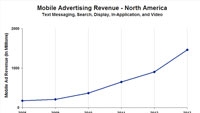Will the mobile screen garner ‘eyeballs for ads’ attention?

Juniper Research’s Windsor Holden thinks advertisers will shift to the mobile screen in the hope that personalization can counter the shrinking audience for ads.
If you’re old enough to be reading this, you can probably easily remember a successful TV advertising campaign from the pre-Internet age. Do "Bet you can't eat just one!" or the Energizer bunny ring any bells? Now, name one TV advertising campaign that impressed you enough to recall it from within the last two years. They’re likely few and far between.
Holden attributes this sad situation not to diminishing advertising talent but to the multiplicity of TV channels that have fragmented viewing audiences and the proliferation of the personal video recorder, which means fewer viewers watch TV live and fast forward past captured commercials. Advertisers know this, and their shaking confidence in TV as a message distributor is manifesting in sharply falling ad rates, not helped by the global depression’s effect on overall advertising budgets.
However, brands still need to sell their products, and they’re looking to alternative media to do it. And this is where the nearly 4 billion active mobile subscriptions worldwide mobile come in. Unlike televisions or desktop PCs, mobile TVs typically only have one user, so you can personalize ads. That one user typically carries his device at all times, so the ad can be pushed 24/7. Handsets let users respond instantly to advertising with click-throughs or a text message, and those responses and response rates can be measured easily in hitherto undreamed of detail.
"Advertising isn't just about delivering ads," says Steve Tranter, VP of broadband and interactive at NDS, whose end-to-end content delivery system is used in AT&T's CruiseCast mobile TV service. "It's also about managing campaigns. Ads on an interactive device are more effective."
"If you take a 30-second [broadcast] TV spot," he says, "in 30 seconds the viewer decides, is it relevant or not? If it's interactive, we've found that a viewer will stay interacting with it for two minutes."
There are also new opportunities for advertising, Tranter says, some of which come out of the very technology that viewers use for skipping ads. "People who have DVRs are more proactive about finding the program they want. When they're searching for a program, it's an opportunity for advertising. If you're watching a DVR and you pause, that's an opportunity to put something on the screen."
The professional video industry's #1 source for news, trends and product and tech information. Sign up below.
Although mobile advertising budgets are still a miniscule 1 percent of the more than $500 billion spent on advertising globally, mobile advertising is simply positioned better than its rival media and is bound to gain fast in share.
"Mobile advertising is poised to take full advantage of opportunities presented by the diffusion of advanced devices such as the smartphone,” says Heather Way, Parks Associates research analyst. “Alongside smartphone proliferation, subscriber growth to 3G network data plans will further accelerate the advancement of mobile advertising in the U.S. and abroad. Advertisers will begin to incorporate mobile into their overall media campaigns as the advertising medium matures into a viable marketing tool.”
